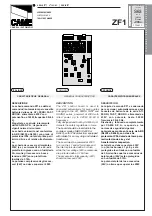
3
ALARM SILENCE
The internal momentary
ALARM SILENCE
switch is
operated to silence an existing energized audible alarm
circuit. The general alarm audible circuit may be op-
tionally silenced by momentary operation of the
ALARM
SILENCE
switch at any time after it has become en-
ergized. The predischarge/discharge audible alarm
circuit may be optionally silenced by momentary op-
eration of the same
ALARM SILENCE
switch, but only
after the selected predischarge period has timed out.
Silencing the general alarm circuit prior to operation
of the predischarge audible circuit does not inhibit the
predischarge circuit audible from its normal operation.
To silence the discharge audible circuit in this case
requires a second
ALARM SILENCE
switch activa-
tion. After silencing either the general alarm circuit and/
or the discharge audible circuit, both remain silenced
until the panel is reset (if alarm condition cleared).
Silence operation of either alarm circuit does not
change the state of the general alarm relay contacts.
Operation of the
ALARM SILENCE
switch, when the
panel is not in an alarm state, has no effect.
SUPERVISORY SILENCE
Operation of the
SUPERVISORY SILENCE
switch to
its Silence position results in silencing the internal su-
pervisory buzzer when the panel is in a supervisory
condition, as indicated by the supervisory light on the
front panel. Operation of the
SUPERVISORY SI-
LENCE
switch to its Silence position when a panel
supervisory condition does not exist causes the su-
pervisory buzzer to operate as it does when the
SU-
PERVISORY SILENCE
switch is in Silence position
and the panel supervisory condition is cleared to a
normal supervisory condition.
TROUBLE SILENCE
Operation of the
TROUBLE SILENCE
switch to its
Silence position results in silencing the internal trouble
buzzer when the panel is in a trouble condition, as
indicated by the trouble light on the front panel. Op-
eration of the
TROUBLE SILENCE
switch to its Si-
lence position when a panel trouble condition does
not exist causes the trouble buzzer to operate as it
does when the
TROUBLE SILENCE
switch is in Si-
lence position and the panel trouble condition is
cleared to a normal supervisory condition.
RELEASE DISCONNECT
The
RELEASE DISCONNECT
switch is a normally
closed single pole switch in series with the release
circuit output. Moving the switch from its normally closed
position during a non-discharge or circuit activation
condition causes an open circuit trouble indication of
the release circuit. This prevents the associated dis-
charge devices from activating.
If the
ALARM SILENCE
switch has been operated after
initiation of the first zone alarm, a second zone alarm re-
sults in reactivating the general alarm audible circuit, which
may then be silenced again.
For NFPA 12A, 13, or 2001 Service:
Place
SERVICE SELECTION
plug in P12.
Connect TB2, terminals 5 and 6 as shown in the Con-
nection Diagram. An open circuit will cause a trouble
condition.
Initiating Circuit and Agent Release Operation
(Selec-
tion Plug Placed on P12). The two initiating zones pro-
vided are arranged so that both zones (cross zoning) must
be alarmed before the agent release discharge sequence
begins.
A single zone alarm condition results in:
1. Alarm lock-in of that zone.
2. Visual alarm indication of that zone.
3. General alarm condition of panel which includes:
a. Change of state of fire alarm relay contacts.
b. General alarm audible circuit activated.
Upon initiation of both zones, the agent discharge delay
sequence begins. The discharge delay period may be
preselected by rotating the Discharge Delay Selection
switch S101 to one of the following time-in periods: 0, 5,
10, 15, 20, 25, 30, 35, 40, or 45 second delay. (Refer to
Option No. 1 below.)
As the discharge delay period begins (both zones alarmed),
and the general alarm audible circuit is de-energized, the
predischarge relay contacts (TB3, terminals 10 through
14) change state (See Option No. 4). The predischarge au-
dible circuit, along with its associated visual indicator, is
cycled at a 2 Hz rate with a 50% duty cycle during the
selected discharge delay period. At the conclusion of the
discharge delay period, the agent release circuit is ener-
gized for approximately 1 minute, while the discharge au-
dible is energized in a steady-on condition until either it is
silenced or the panel is reset to a non-alarm condition.
MANUAL SWITCHES
System
RESET/LAMP TEST
Upon initiation of either Zone 1 or Zone 2 and/or op-
eration of the manual
DISCHARGE PRESSURE
switch, the Control Panel locks into an alarm condi-
tion. This alarm condition may only be reset by opera-
tion of the internal momentary
RESET/LAMP TEST
switch. While this switch is held in the Reset position,
all indicating lamps, except
POWER
and charge cur-
rent operation
BATTERY CHARGER
are lit. It should
be noted that the Control Panel cannot be reset while
the manual
DISCHARGE PRESSURE
switch is in the
closed position.
Technical Manuals Online! - http://www.tech-man.com






























